Final Statistical Monitoring Report on the Implementation of China National Program for Child Development (2011–2020)
National Bureau of Statistics of China,
December 2021
In order to promote healthy growth and comprehensive development of children, the Government of China promulgated and began implementing the China National Program for Child Development (2011-2020) in 2011, hereinafter referred to as the NPA for Children. Recently, the National Bureau of Statistics conducted the final statistical monitoring of the implementation of the NPA for Children in five areas including health, education, welfare, environment and legal protection based on the relevant statistics and monitoring data on the NPA for Children indicators. The results show that the key targets of the NPA for Children have been achieved as planned over the past 10 years. Children's health status has progressively improved, their level of education has continually increased, and their access to welfare has steadily expanded. Furthermore, the environment needed for children’s growth and development has been advanced, and the legal system and mechanisms for child protection have also been enhanced. However, the gap between urban and rural areas in child development is still apparent, and the protection of children's rights and interests in related fields still needs to be strengthened.
I. Achievements of the NPA for Children in Five Areas
1. Children and Health
1.1) The health status of children has improved significantly. Since the implementation of the NPA for Children, the capacity to deliver children's medical and health services has comprehensively improved; the prevention and treatment of birth defects have achieved remarkable results; child mortality rates have continually declined; and the health status of children has significantly improved. The incidence of serious and disabling birth defects dropped from 17.47 per 10,000 births in 2010 to 10.40 per 10,000 births in 2020, a decrease of more than 40%. The infant mortality rate (IMR) and under-five mortality rate (U5MR) targets outlined in the NPA for Children (IMR<10‰; U5MR<13‰) were achieved in 2013, and have both been declining for seven consecutive years since then. In 2020, the IMR was 5.4‰ and the U5MR was 7.5‰ (see Figure 1), 7.7 and 8.9 millesimal points lower than that in 2010, respectively.
Figure 1. Infant Mortality Rate and Under-five Mortality Rate, 2010-2020

1.2) Disease prevention and treatment for children has achieved remarkable results. Since the implementation of the NPA for Children, immunization planning, monitoring, and management systems at the national, provincial, prefecture and county levels have been gradually strengthened; immunization service networks have been progressively established at the county, township and village levels; coverage rates of vaccinations included in the National Immunization Program remained high; and the spread of common communicable diseases among children have been effectively controlled. In 2020, all coverage rates of age-appropriate vaccinations [1] included in the National Immunization Program for children reached or exceeded 99% (see Figure 2). In 2020, the incidence rates of measles and Japanese encephalitis decreased to 0.06 per 100,000 children and 0.02 per 100,000 children, respectively. The incidence rate of neonatal tetanus continued to remain below 1‰, and China achieved the goal of eliminating neonatal tetanus in 2012 as certified by the World Health Organization.
Figure 2. Coverage Rates of Vaccinations Included in the National Immunization Program, 2020
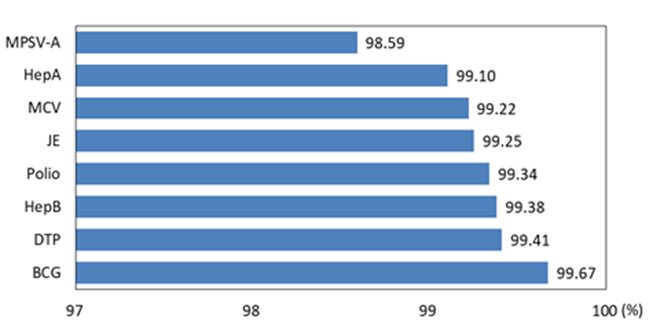
1.3) Children’s growth and development have continuously improved. Since the implementation of the NPA for Children, the Child Nutrition Improvement Initiative has been effectively promoted; more emphasis has been placed on scientific feeding of infants and young children; and the nutritional status of children has continuously improved, especially among those in poverty-stricken areas. In 2020, the incidence of low birth weight among children was 3.25%, achieving the target outlined in the NPA for Children (incidence of low birth weight<4%). The prevalence of anemia, stunting and underweight among children under-five were 4.51%, 0.99%, and 1.19%, respectively, which was 0.87, 0.13, and 0.36 percentage points lower than that in 2010. These achievements have met the targets of the NPA for Children (prevalence of anemia<12%, prevalence of stunting<7%, prevalence of underweight<5%) [2].
1.4) The incidence of child injury has been effectively limited. The issue of child injury has received significant attention since the implementation of the NPA for Children. Child injury prevention networks have steadily improved, awareness of the importance of actively preventing child injury has noticeably increased, and the injury-related mortality rate among children has decreased significantly. The injury-related mortality rate among children under age 18 dropped from 22.41 per 100,000 children in 2010 to 11.06 per 100,000 children in 2020, a decrease of 50.6%, achieving the target set out in the NPA for Children (i.e., reduce the injury-related mortality rate by 1/6).
2. Children and Education
2.1) The development of pre-primary education has been accelerated. Since the implementation of the NPA for Children, three consecutive pre-primary education action plans have been implemented to continuously expand the supply of affordable resources and improve the quality of early childhood education. A public service system for pre-primary education with wide coverage, basic guarantees, and quality has been essentially established. In 2020, the national gross enrollment ratio for pre-primary education was 85.2%, an increase of 28.6 percentage points from 2010, which is far higher than the 70% target of the NPA for Children. In 2020, there were 292 thousand kindergartens nationwide, of which 124 thousand were public kindergartens and 168 thousand were private kindergartens (see Figure 3), which was 1.9 times [3], 2.6 times and 1.6 times that of 2010, respectively. There were 2.91 million full-time kindergarten teachers nationwide in 2020, 2.5 times the number in 2010.
Figure 3. Number of Kindergartens and Gross Enrollment Ratio in Pre-primary Education, 2010–2020

2.2) Compulsory education has been universalized. Since the implementation of the NPA for Children, the reform of the nine-year compulsory education has steadily deepened, and compulsory education has been universalized. The balanced development of compulsory education continues to be promoted, and the quality of compulsory education has been further improved. In 2020, the survival rate of nine-year compulsory education reached 95.2% (see Figure 4), or 4.1 percentage points higher than that in 2010, achieving the 95% target outlined in the NPA for Children. Since 2010, the net enrollment rate of primary school-age children has remained above 99.7%, and the primary school transition rate has remained above 98%. In 2020, there were 211 thousand compulsory education schools nationwide, with 10.29 million full-time teachers, an increase of 12.6% since 2010, and 156 million students enrolled in school, an increase of 2.8% since 2010. In 2020, there were 14.30 million children of migrant workers enrolled in compulsory education in receiving cities, accounting for 9.1% of students in school, and 1.5 percentage points higher than that in 2010.
Figure 4. Survival Rate of Nine-Year Compulsory Education, Net Enrollment Rate of Primary School-Age Children, and Primary School Transition Rate, 2010-2020
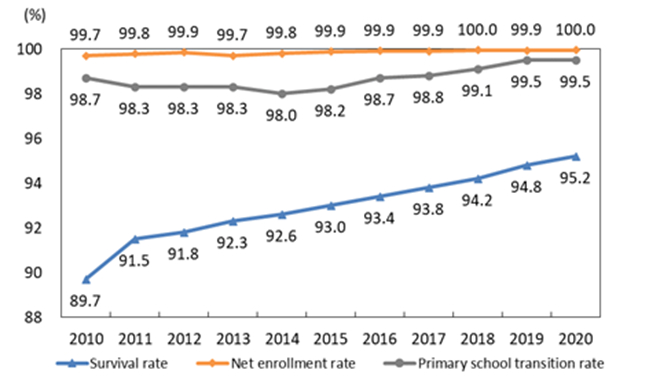
2.3) Advancement of senior secondary education [4] has reached a new stage. Since the implementation of the NPA for Children, and through the promulgation and implementation of the Outline of the National Medium and Long-term Education Reform and Development Plan (2010-2020) and the National Plan on the Universalization of Senior Secondary Education (2017-2020), the scale of senior secondary education has steadily expanded and the quality of education has progressively improved, with significant achievements overall. In 2020, the national gross enrollment ratio for senior secondary education was 91.2%, an increase of 8.7 percentage points from 2010, achieving the 90% target outlined in the NPA for Children. There were 24,457 senior secondary schools nationwide in 2020, of which 9,896 were vocational secondary schools. 15.21 million students were newly admitted to senior secondary education and 41.63 million students were enrolled in senior secondary education. Among them, 6.45 million students were newly admitted to vocational secondary education and 16.63 million students were enrolled in vocational secondary education, accounting for 42.4% and 40.0% of senior secondary education, respectively.
2.4) The scale of special education has continued to expand. Since the implementation of the NPA for Children, two special education promotion plans have been implemented successively; education opportunities for people with disabilities have been continuously improved, and the level of universalization has increased significantly. In 2020, there were 2,244 special education schools and 66 thousand full-time teachers nationwide, an increase of 31.5% and 66.9% since 2010, respectively. 149 thousand students were newly admitted to various types of special education [5], and a total of 881 thousand students were enrolled in special education. This was 2.3 times and 2.1 times that of 2010, respectively. Nationwide, there were 864 thousand students enrolled in special education at the compulsory education stage, 2.1 times that of 2010.
3. Children and Welfare
3.1) The establishment of child welfare institutions and child protection centers have been steadily promoted. Since the implementation of the NPA for Children, the establishment of child welfare institutions and child protection centers have been continuously strengthened, and the number of institutions increased steadily, providing a strong foundation for the delivery of child welfare and protection services. By the end of 2020, there were 760 child welfare institutions and child protection centers nationwide (see Figure 5), an increase of 280 institutions/centers since end 2010. These institutions/centers had 101 thousand beds in total, an increase of 45 thousand beds since end 2010. Specifically, there were 508 child welfare institutions with 91 thousand beds, and 252 child protection centers with 10 thousand beds. In 2020, street children were assisted 31 thousand person-times.
Figure 5. Number of Child Welfare Institutions and Child Protection Centers, 2010 and 2020
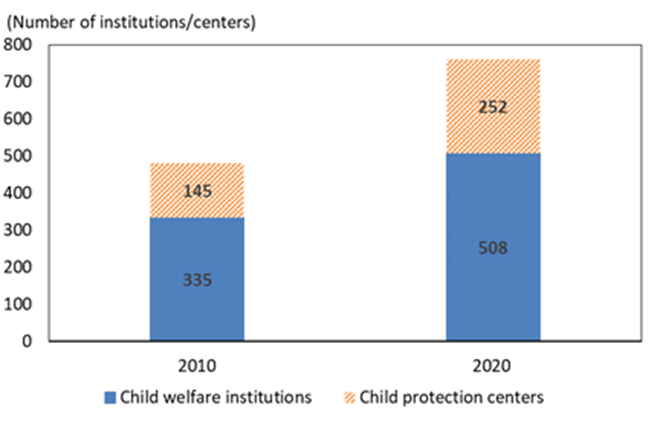
3.2) The living conditions of orphans have improved significantly. Since the implementation of the NPA for Children, the Opinions on Strengthening the Protection of Orphans issued by the General Office of the State Council in 2010 has been fully carried out. The central government allocated special funds to subsidize the basic living expenses of orphans, and the living conditions of orphans have significantly improved. The incidence of child abandonment has decreased significantly, and the total number of orphans has been declining for eight consecutive years. As of the end of 2020, there were 193 thousand orphans nationwide; among them, 59 thousand were in state care and 134 thousand were in kinship care. In 2020, the average monthly basic subsistence allowance standards for state care and kinship care were RMB 1,611.3 and RMB 1,184.3, respectively, an increase of RMB 467.6 and RMB 391.4 from 2016[6] . In 2020, 11 thousand orphans were adopted by families, accounting for 5.7% of the total number of orphans.
3.3) Rehabilitation services for children with disabilities has significantly improved. Since the implementation of the NPA for Children, the Government has implemented the rescue rehabilitation project for children with disabilities and established a rehabilitation assistance mechanism. At present, the national rehabilitation assistance policy system, working mechanism and service network for children with disabilities have been fully established, providing a strong foundation for rehabilitation assistance of children with disabilities. As of the end of 2020, there were 10,440 rehabilitation organizations that provided services for children with disabilities (see Figure 6), an increase of 7,300 institutions since 2011. In 2020, a total of 237 thousand children with disabilities aged 0-6 across the country received basic rehabilitation services, an increase of 87 thousand children since 2016 [7]. Among persons with disabilities receiving basic rehabilitation services, the proportion of children aged 0-6 was 2.2%.
Figure 6. Number of Rehabilitation Organizations Providing Services for Children with Disabilities, 2011-2020
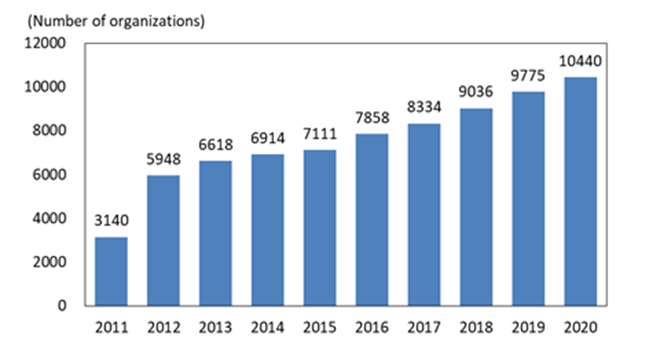
4. Children and the Environment
4.1) The living environment of children has gradually improved. Since the implementation of the NPA for Children, with the ongoing ecological civilization construction and the increased awareness on ecological and environmental protection, the ecological environment has steadily improved and the living environment of children has become healthier. In 2020, the park and green space per capita in urban areas across the country was 14.8 square meters, which is 3.6 square meters more than that in 2010. The greenery coverage of urban built-up area, the urban sewage treatment rate, and the rate of harmless disposal of household solid waste in urban areas were 42.1%, 97.5%, and 99.7%, respectively, an increase of 3.5, 15.2, and 21.8 percentage points from 2010. The proportion of rural population benefiting from centralized water supply reached 88.0%, an increase of 30 percentage points since 2010.
4.2) The social environment for children has steadily improved. Since the implementation of the NPA for Children, the construction of urban and rural community service systems has been actively promoted, and Children’s Places established by urban and rural communities have become a second home to support the healthy growth of children. By the end of 2020, there were 448 thousand community service centers (or stations) nationwide (see Figure 7), which was 7.9 times that of 2010; there were 321 thousand [8] Children's Places (or Children's Centers), which was 6.7 times that of 2012 [9]; and there were 71 thousand certified professional social workers in grassroots organizations, which was 7.8 times that of 2010.
Figure 7. Number of Community Service Centers (or Stations) and Certified Professional Social Workers in Grassroots Organizations, 2010-2020

4.3) Cultural products for children have become more abundant. Since the implementation of the NPA for Children, there has been continued increase in quality cultural products for young people and children, gradually meeting their growing cultural needs. In 2020, for students in junior secondary education and below, there were 43 thousand types of children's books with 904 million copies published, and 209 types of children’s periodicals with 335 million copies published. There were 151 million volumes of children's literature in 3,212 public libraries across the country, which was 4.9 times that of 2011. The broadcasting time of children's radio programs, children’s television programs, and animated television programs were 288 thousand hours, 631 thousand hours, and 446 thousand hours, respectively (see Figure 8), which were 2.1 times, 1.7 times, and 1.6 times that of 2011. In 2020, children visited museums across the country 122 million person-times.
Figure 8. Broadcasting Hours of Children’s Radio Programs, Children’s Television Programs and Animated Television Programs, 2011-2020
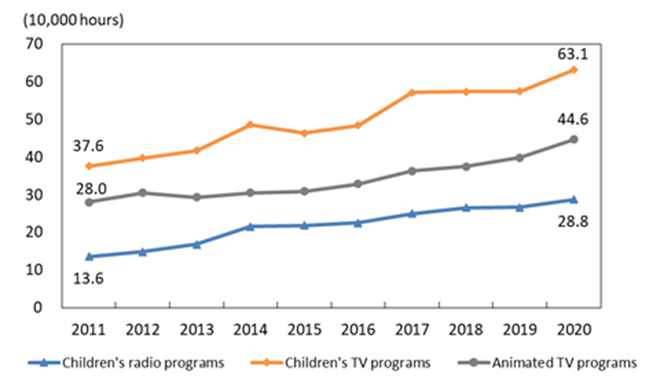
5. Children and Legal Protection
5.1) The legal and regulatory systems for the protection of children's rights and interests have been further improved. Since the implementation of the NPA for Children, the development of China’s child rights protection system has continuously advanced. The Constitution forms the basis and foundation of this system, with special laws such as the Law on the Protection of Minors, the Law on the Prevention of Juvenile Delinquency and the Compulsory Education Law at its core, supported by general laws such as the Civil Code and the Criminal Law. Overall, the legal protection system for children's rights and interests has been essentially established, the awareness on the protection of children's rights has continuously improved, and important progress has been achieved in the legalization of children's rights and interests.
5.2) Promising results have been achieved in combatting crimes against children. Since the implementation of the NPA for Children, the Government has continued to conduct special operations on anti-trafficking and utilized various measures to find missing and trafficked children. The capacity to combat and prevent crimes that violate the legal rights and interests of children has steadily increased; the numbers of kidnapping and trafficking cases have dropped sharply; and the legal rights and interests of children have been effectively protected. Since the platform for the dissemination of urgent information on missing children was established in 2016, a total of 4,930 missing children alerts have been published, and 4,858 missing children have been successfully found with a recovery rate of 98%.
5.3) The capacity to provide legal aid services to children continues to improve. Since the implementation of the NPA for Children, legal aid support for children has been actively promoted; the application process for legal aid services has become simpler; the scope of legal aid services has gradually expanded; and the quality of legal aid services has continuously improved. In 2020, children across the country received assistance from legal institutions, totaling 120 thousand person-times, an increase of 33 thousand person-times or 37.7% from 2010. In 2020, women's federations at or above the county level responded to complaints from women and children more than 188 thousand times.
5.4) Preventing juvenile delinquency has achieved positive results. Since the implementation of the NPA for Children, the working mechanism for preventing juvenile delinquency has continuously improved, the number of juvenile criminal cases has steadily declined, and the rate of juvenile delinquency has dropped significantly. In 2020, there were 34 thousand juvenile criminals nationwide, a decrease of 50.5% from 2010. The number of juvenile criminals accounted for 2.21% of the total number of criminals in the same period, a decrease of 4.57 percentage points from 2010.
II. Key Challenges during the Implementation of the NPA for Children
1. Significant gaps in children’s health between urban and rural areas and by region
Since 2010, the health status of children in China has improved significantly, however, gaps persist between urban and rural areas and by regions. In 2020, the IMR and U5MR in rural areas were 6.2‰ and 8.9‰, respectively, higher than the 3.6‰ IMR and 4.4‰ U5MR in urban areas. By region, the IMR and U5MR in the western region were 7.9‰ and 10.6‰, respectively, higher than the 4.7‰ IMR and 6.6‰ U5MR of the central region, and the 2.7‰ IMR and 4.1‰ U5MR of the eastern region.
2. Establishment of Children’s Places needs to be strengthened
In recent years, the establishment of Children’s Places has been vigorously promoted in urban and rural communities across the country. While the number of Children’s Places has increased significantly, it still fell short of the target set out in the NPA for Children. By the end of 2020, there were 321 thousand Children’s Places (or Children’s Centers) nationwide, not achieving the target. The relatively slow establishment of Children’s Places in the central and western regions of the country is also more evident. In some areas, the proportion of communities with Children’s Places is relatively low, and less than 10% in several provinces.
Notes:
1. The vaccines included in the National Immunization Program relevant to this report are bacille Calmette-Guerin (BCG), polio, diphtheria-tetanus-pertussis (DTP), measles (MCV), hepatitis B (HepB), hepatitis A (HepA), Japanese encephalitis (JE) and meningococcal (MPSV-A).
2. Data for nutrition indicators in this paragraph are from the annual reporting on maternal and child health by the National Health Commission.
3. The total numbers and percentages presented may have calculation errors due to the use of different units of measurement, and no manual adjustments have been made.
4. The senior secondary education stage includes regular senior secondary school, regular specialized secondary education, senior secondary vocational school, and vocational-technical school, etc..
5. This includes students attending special education schools, special education classes of regular schools, regular classes of regular schools, and those receiving home-based educational support.
6. The Ministry of Civil Affairs has been publicizing the standards for average monthly basic subsistence allowance for orphans since 2016.
7. Since 2016, the unit of measurement to calculate “children with disabilities receiving basic rehabilitation services” changed from person-times to persons.
8. The number of Children's Places is based on data provided by the All-China Women's Federation. The same applies below.
9. The All-China Women's Federation has collected relevant statistics since 2012.
